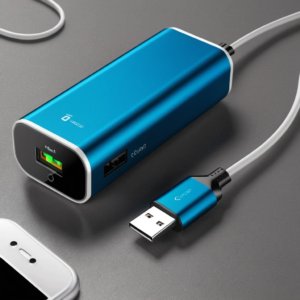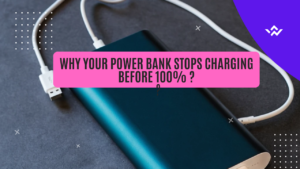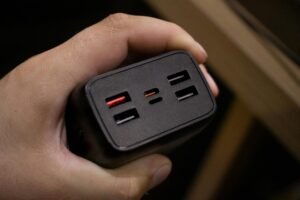A fast charging cable is a specially designed cable that can transfer more power to your device compared to regular cables, allowing it to charge much faster. It works by supporting higher current or voltage levels and often uses advanced technology like USB-C or Quick Charge standards to speed up the charging process, provided your device and charger are compatible.
I remember the first time I tried a so-called “fast charging” cable that I bought from a corner store. It didn’t speed anything up; it just got warm and stopped working after a week. Lesson learned: not all cables labeled “fast charging” are legit. Look for terms like “Quick Charge” or “Power Delivery” when shopping for one.
What Makes a Cable “Fast Charging”?
Here’s the deal: the secret sauce of fast charging is in the current it can handle and the quality of its materials. A good fast charging cable supports higher amperage, like 3A or more, and is built with thicker internal wires to handle the extra power without overheating.
Cheap cables? They can’t handle the power. I had one melt (seriously, it smelled awful). Now I always check for certifications like USB-IF or Qualcomm Quick Charge compatibility before buying.
Types of Fast Charging Cables
What is a 3A Fast Charging Cable?
A 3A (amp) cable can carry more current than standard 1A or 2A cables. This means it charges your devices faster when paired with a compatible charger. Think of it like a wider pipe carrying more water.
I once tried charging my phone with an old cable, and it took hours. Switched to a 3A cable, and boom—fully charged in under an hour. If you’re buying one, make sure the cable is sturdy and thick because flimsier cables tend to fail under the higher load.
What is a Type-C Fast Charging Cable?
USB Type-C cables are like the Swiss Army knives of charging. They can handle higher power levels (up to 100W in some cases) and faster data transfer speeds. Plus, they’re reversible—no more fumbling in the dark trying to plug it in the right way.
But not all USB-C cables are created equal. Some are just for charging, while others support high-speed data transfer. Once, I grabbed a cheap USB-C cable online, and it couldn’t even power my laptop properly. Now I stick to brands that list wattage and compatibility clearly.
Are All Type-C Cables Fast Charging?
Nope! Some Type-C cables are just plain vanilla—good for slow charging and basic use. Always check the specs, like “PD” (Power Delivery) or wattage ratings. Trust me, I’ve made the mistake of buying a $5 cable and wondering why my phone charged slower than a snail on a lazy day.
Does It Matter What USB-C Cable You Use?
Yes, it does! Using a low-quality USB-C cable can damage your devices or result in painfully slow charging. I once used an off-brand cable, and it caused my charger to overheat. Since then, I’ve learned to look for cables rated for my charger’s wattage—like 65W for my laptop or 18W for my phone.
Fast Charging Cables for Specific Devices
Fast Charging Cables for Apple Devices
When it comes to Apple, their ecosystem has a knack for being… let’s say, exclusive. To take full advantage of fast charging, you’ll need a Lightning to USB-C cable and a power adapter capable of delivering 20W or more. But don’t just grab any cable—make sure it’s MFi (Made for iPhone) certified. Apple devices are picky, and uncertified cables might work today but stop working tomorrow after a software update.
I’ve personally been burned by cheap, uncertified cables. Once, I bought a generic Lightning cable for half the price of an Apple-certified one, and it lasted a month before the dreaded “Accessory not supported” message popped up. Lesson learned!
Here are some reliable options on Amazon:
- Apple USB-C to Lightning Cable (1m) – A bit pricey, but it’s Apple’s official cable, so you know it’ll work seamlessly.
- Anker 641 USB-C to Lightning Cable – Durable, braided, and MFi-certified. It’s also available in fun colors!
- Belkin BoostCharge Lightning to USB-C Cable – Trusted brand and perfect for both charging and data transfer.
Fast Charging Cables for Android Devices
Android users have it a bit easier since most modern devices use USB-C cables. Depending on your phone, you might need one that supports Qualcomm Quick Charge or USB Power Delivery (PD). Many Android devices now support charging speeds of 18W, 30W, or even higher, so it’s crucial to pair the cable with the right charger.
I’ve been an Android user for years, and I can’t tell you how many times I’ve accidentally grabbed an older Micro-USB cable instead of a USB-C. It’s frustrating! Now, I always keep a spare Type-C cable in my car, bag, and office.
Here are some top-rated Android fast charging cables on Amazon:
- Anker PowerLine+ III USB-C to USB-C Cable – Sleek, tough, and supports up to 100W charging. Perfect for phones, tablets, and even laptops.
- Baseus USB-C to USB-C Cable (100W) – A budget-friendly option that doesn’t skimp on performance. Great for high-wattage charging.
- Samsung USB-C Fast Charging Cable – Ideal for Samsung Galaxy devices and supports Super Fast Charging.
What is the Best Universal Fast Charging Cable?
A universal fast charging cable is the holy grail for anyone juggling multiple devices. Look for USB-C to USB-C cables with Power Delivery support, as they work with most phones, tablets, laptops, and accessories. Bonus points if the cable includes adapters for Lightning or Micro-USB—this makes it a true universal solution.
I’ve been using a 6ft USB-C to USB-C cable with a 100W rating, and it’s become my go-to for charging everything from my MacBook to my Android phone. Pro tip: get one with a braided design to prevent tangling and wear.
Top universal cables on Amazon include:
- Cable Matters USB-C to USB-C Cable (100W) – A versatile option for high-wattage charging. It’s perfect for traveling.
- Ugreen USB-C to USB-C Cable (100W) – Compact and reliable, with great reviews for charging a wide range of devices.
By investing in a high-quality fast charging cable that suits your needs, you can save time and prolong the life of your devices. Always check reviews and compatibility details before buying—trust me, it’s worth it! If you’d like, I can expand on how to pair these cables with the right chargers.
Identifying and Selecting Fast Charging Cables
Navigating the world of charging cables can be a bit of a maze, but with some practical tips and personal insights, you’ll be well-equipped to make informed choices.
How to Identify a Fast Charging Cable
Fast charging cables are essential for quickly replenishing the battery of your smartphone, tablet, or other devices. However, not all cables are created equal, and identifying a true fast charging cable can save you time and frustration. Here’s how you can spot one:
1. Look for Compatibility with Fast Charging Standards
Fast charging cables are designed to work with specific standards like:
- USB Power Delivery (USB-PD): Widely used for fast charging, especially for USB-C devices.
- Qualcomm Quick Charge: Common in many Android devices.
- Other Proprietary Standards: Brands like Samsung, OnePlus, and Apple may have their own fast charging protocols.
Check the cable’s packaging or specifications to ensure it supports the required standard for your device.
2. Check the Cable’s Power Rating
Fast charging cables are designed to handle higher currents. Look for:
- Amperage Rating: At least 2A (amps) or higher. Standard cables may support only 1A or less.
- Wattage Rating: Cables supporting fast charging often have a wattage rating of 18W or more.
3. Inspect the Connectors
High-quality fast charging cables often have sturdy and well-constructed connectors. USB-C connectors are generally associated with faster charging speeds compared to Micro-USB or standard USB-A connectors.
4. Examine the Cable Thickness
Fast charging cables are typically thicker than regular ones due to the need to carry higher currents. The increased thickness accommodates additional wires and better insulation.
5. Verify Data Transfer Speeds
Fast charging cables usually support high-speed data transfer, as they are made with higher quality materials and better technology. Look for terms like “USB 3.0” or “USB 3.1,” which indicate faster data and power delivery capabilities.
6. Look for Certified Cables
Certified cables are more likely to meet fast charging standards. Certifications to look for include:
- USB-IF Certification: Indicates the cable meets USB standards.
- MFi Certification: For Apple devices, ensures compatibility and performance.
7. Use a Power Meter or Charging App
To confirm whether a cable is fast charging, you can use a power meter or a smartphone app that measures charging speeds. These tools can show the voltage and current being delivered.
8. Brand and Quality
Reputable brands such as Anker, Belkin, or Aukey often produce reliable fast charging cables. Avoid unbranded or extremely cheap cables, as they may not meet safety and performance standards.
How Do I Know What Charging Cable I Need?
First off, identify your device’s charging port: is it USB-C, Lightning, or Micro-USB? This determines the type of cable you’ll need. I recall purchasing a USB-C cable for my older Kindle, only to realize it required a Micro-USB connection—rookie mistake!
Next, consider your device’s charging capabilities. Does it support fast charging? If so, what specifications does it require? For instance, some devices need a cable that supports higher amperage, like 3A or more, to achieve optimal charging speeds. I once used a standard cable with my fast-charging phone and wondered why it was charging at a snail’s pace. Turns out, the cable couldn’t handle the required current.
To make things easier, here’s a quick reference table:
| Device Type | Charging Port | Recommended Cable Specification |
|---|---|---|
| Modern Android Phones | USB-C | USB-C to USB-C, 3A or higher |
| iPhones | Lightning | Lightning to USB-C, MFi certified |
| Older Devices | Micro-USB | Micro-USB to USB-A, standard |
Always check your device’s manual or manufacturer’s website for specific recommendations. It saves time and prevents the frustration of incompatible accessories.
How to Tell the Difference Between a USB Charging Cable and a Data Cable?
At first glance, charging and data cables might look identical, but they serve different functions. Charging cables, often referred to as “charge-only,” have power wires but lack data transfer lines, meaning they can’t sync data between devices. Data cables, on the other hand, support both charging and data transfer.
I learned this distinction the hard way when I couldn’t get my phone to connect to my computer using a particular cable. After some digging, I discovered it was a charge-only cable. Now, I ensure to purchase cables labeled as “data sync” or “charging and data” to cover all bases.
A practical tip: data cables are usually slightly thicker due to the additional wires inside. However, this isn’t a foolproof method, so always check the product specifications or labeling.
Do You Need a Special Cable to Fast Charge?
In short, yes. Fast charging requires cables that can handle higher currents and, in some cases, higher voltages. Standard cables might not support the necessary power levels, leading to slower charging times or even potential safety hazards.
I once tried using an old cable to fast charge my new phone, only to find it became unusually warm. That was a wake-up call about the importance of using appropriate cables. Since then, I’ve stuck to cables from reputable brands that specify support for fast charging.
Here are some popular fast charging cables available on Amazon:
Anker USB C to USB C Cable
A 6-foot cable supporting up to 60W fast charging, suitable for a wide range of devices.
AINOPE USB C Cable 60W
A 2-pack of 6.6ft nylon braided cables with right-angle design, supporting fast charging for various devices.
Apple USB-C Woven Charge Cable (1 m)
Official Apple cable designed for fast charging and syncing of Apple devices.
etguuds USB to USB C Cable 3ft
A 2-pack of USB A to Type C charger cords, suitable for fast charging Samsung Galaxy and other devices.
Basesailor iPhone 16 15 Pro Max Charger Cord
USB to USB C cable, 6.6ft/2Pack, compatible with Apple iPad 10, Samsung Galaxy, and Google Pixel devices.
When selecting a cable, look for terms like “fast charging,” “Quick Charge,” or “Power Delivery” in the product description. Additionally, ensure the cable’s amperage and wattage ratings align with your charger’s output and your device’s requirements.
5. Specifications and Requirements for Fast Charging
Understanding the technical aspects of fast charging can be a game-changer in optimizing your device’s performance.
5.1 Is a 2.4A Cable Considered Fast Charging?
A 2.4A (ampere) cable does offer faster charging compared to standard 1A cables. However, with the advent of newer technologies, it’s now considered moderate. Many modern devices and chargers support higher currents, such as 3A or even 5A, enabling significantly faster charging speeds.
I remember being thrilled with a 2.4A cable’s performance a few years back. But as technology advanced, I noticed it couldn’t keep up with my newer gadgets. Upgrading to a 3A cable made a noticeable difference in charging times.
Here’s a quick comparison:
| Cable Amperage | Charging Speed | Suitable For |
|---|---|---|
| 1A | Slow | Older devices, basic phones |
| 2.4A | Moderate | Mid-range smartphones, tablets |
| 3A and above | Fast | Modern smartphones, laptops |
Always ensure your device and charger are compatible with the cable’s amperage to achieve optimal charging speeds.
5.2 How Do I Know What Wattage My Charging Cable Is?
Determining a cable’s wattage involves understanding its amperage and voltage ratings. Wattage is calculated by multiplying these two values (Wattage = Amperage x Voltage). For example, a cable supporting 3A at 5V delivers 15W of power.
Many reputable cables have their specifications printed on them or listed in the product description. I once bought a cable without checking its specs, only to find it couldn’t charge my tablet efficiently. Now, I always verify the cable’s ratings before making a purchase.
If the information isn’t readily available, consider reaching out to the manufacturer or opting for a different product with clearly stated specifications.
5.3 Is There a Difference Between a Normal Charging Cable and a Fast Charging Cable? (Continued)
Fast charging cables typically feature better insulation and higher-quality materials to safely deliver higher currents and voltages. Regular cables, on the other hand, might struggle to transmit power efficiently, resulting in slower charging speeds and potential overheating.
I learned this difference after using an old cable for my fast-charging phone. The device charged sluggishly, and the cable got noticeably warm. Upgrading to a certified fast-charging cable not only improved charging times but also kept the cable cool and safe to touch. Look for cables labeled with “Quick Charge” or “Power Delivery” for the best results.
Here’s a breakdown of the key distinctions:
| Feature | Normal Charging Cable | Fast Charging Cable |
|---|---|---|
| Current Support | 1A-2A | 3A and above |
| Voltage Range | Standard 5V | Up to 20V (with Power Delivery) |
| Material Quality | Basic | Enhanced (nylon braided, etc.) |
| Charging Speed | Slower | Faster |
| Data Transfer Speeds | Varies | Often faster |
When shopping for fast charging cables, prioritize reputable brands and certifications like MFi (for Apple) or USB-IF.
5.4 What Cable Is Needed for Super Fast Charging?
Super fast charging, such as Samsung’s 45W charging or OnePlus Warp Charge, requires specialized cables designed for higher power delivery. These cables can handle up to 5A and support voltages beyond the typical 5V, often utilizing advanced technologies like USB Power Delivery (USB-PD).
I encountered this when I switched to a Samsung Galaxy phone with a 25W charger. My older 3A cable just couldn’t keep up. After purchasing an official Samsung USB-C to USB-C 5A cable, the difference was night and day—charging from 0% to 50% in just 20 minutes.
Popular cables for super fast charging include:
| Product | Key Features | Price (Approx.) | Buy Link |
|---|---|---|---|
| Anker Powerline+ III | Supports USB-PD, 100W power, and nylon braided | $9.99 | Amazon Link |
| Samsung USB-C to USB-C 5A | Designed for Samsung Super Fast Charging | $14.99 | Amazon Link |
| Baseus USB-C Cable 100W | 5A support, LED display for charging status | $12.99 | Amazon Link |
When choosing a cable for super-fast charging, ensure it matches your charger and device’s specifications. For instance, a 45W charger requires a cable rated for at least that wattage.
Final Thoughts on Choosing Fast Charging Cables
Investing in the right charging cable isn’t just about speed—it’s about safety, efficiency, and convenience. A well-chosen cable can extend your device’s lifespan and save you time. Always prioritize quality over cost when it comes to fast charging, and don’t hesitate to splurge a little on reputable brands.
Remember, the best cable for your needs depends on your device, your charger, and how often you use them. If you’re like me and constantly on the go, a durable, fast-charging cable can feel like a lifeline. Happy charging! 🔌





Pingback: What is a Fast Charger Adapter? Discover the Best Solution for Quick and Efficient Charging! - Hyper Chargers Headquarters
Pingback: Top 6 Fast Charging Station: The Ultimate comparison - Hyper Chargers Headquarters
Pingback: Best 5 Fast Charging Cables for 2025: USB A to USB C - Hyper Chargers Headquarters
Pingback: Top 5 Amazon Best Sellers Fast Charging Cables: USB-A to MFi Certified Lightning Cables - Hyper Chargers Headquarters
Pingback: The Top 5 fast iphone chargers in 2025 - Hyper Chargers Headquarters